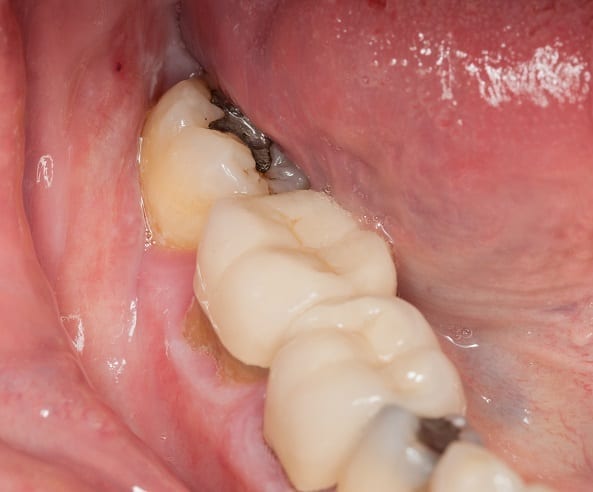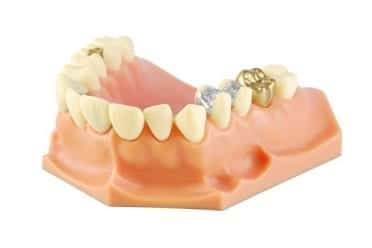For most people, the default choice for fillings would seem to be colored ones, especially if your cavities are not severe. However, thanks to the advances of dental technology, you’re no longer relegated to just one option when filling up those holes in your teeth. Aside from composite filings, you can also use dental amalgam. Both have their respective pros and cons. The main and most obvious difference between the two is the color. Resin composite, white, or teeth-colored filings use materials that are made from things that match your teeth color. Meanwhile, amalgam filings are made of metal instead.
Since each filling type has its own list of advantages and disadvantages, let’s take a closer look at what those pros and cons are. Doing so can help you make a more informed decision when deciding how to deal with your dental cavities efficiently and dependably.
What Are Colored Fillings?

Colored fillings—also known as composite or resin composite fillings—are made with ceramic and plastic compounds. From the start, dentists weren’t able to use colored fillings at the back of the mouth where the molars are. This is because resin tends to break under the bite forces of your molars, which are extra strong when you grind and chew.
- A Toothy Shade: Colored fillings are colored like your teeth. This is what makes them ideal when it comes to fixing your front teeth, where an off-color filling will be most obvious to the naked eye. However, they’re not only reserved for front teeth anymore. This hasn’t been the case for years. It’s the filling of choice for cosmetic dentistry for sure.
- Composite Fillings at the Back: There are now extra-strength composite fillings capable of surviving the biting strength of molars at the back of your jaw. These composite or colored fillings are however not chosen for several other reasons other than quality or strength. For example, dental plans have no coverage for colored filings for molars. You might need to pay out-of-pocket for that service.
- Front Teeth Mostly: There are dentists who view using dental fillings at the back of the mouth a waste because they think they’re reserved for restoring a person’s smile by their use on front teeth. Other dentists forego this advanced method of filling in cavities because they still can’t last a long time and can wear out easily due to all that grinding and chewing.
- Invisible and Easy Adhesion: Because colored filings are the same color as your teeth, it’s easier for them to blend in with the rest of your teeth. Furthermore, they easily adhere to your toot surface because the resin composite material is made for easy dentin and enamel bonding. Granted, if the cavity becomes too big, no amount of filling will be enough to fill out that hole and have it stick.
- Preservation and Frequent Usage: Colored fillings are the fillings you should use in order to preserve the maximum amount of tooth possible. This resin’s flexibility also means less drilling is needed so your remaining tooth won’t have to be further destroyed. What’s more, it’s the most frequent replacement option up until the molars closest to your canines and incisors or front teeth.
- Needs Frequent Replacement: Alas, resin composite tooth-colored fillings last 5-7 years, which is half the lifespan of amalgam filling that could last from 8-10 years if you take care of them properly. If you want a longer-lasting option, then go with amalgam. You’ll need to undergo more dentist visits with colored fillings in exchange for their aesthetic pleasantness.
- Takes Longer to Put In: It’s more involved to put in a resin filling compared to an amalgam one. It takes more of your time or day at the dentist clinic. It might not require much drilling and can bond easily with the rest of the tooth, but it still needs a special laser light to set or harden the material, among other processes. Amalgam is quicker and bonds more reliably without the need of a lamp.
What Are Dental Amalgam Fillings?
Dental amalgam has withstood the test of time since its creation even after it was succeeded by colored fillings. The reason for this longevity in dentist usage is because the filling itself offers superior longevity to its resin composite counterpart. It didn’t become altogether obsolete because there are certain things colored fillings cannot do that the tough amalgam fillings can.
- The Older and Tested Option: Most dentists choose the traditional, older, and most tested option when it comes to molar fillings known as amalgam fillings. They can survive a beating from all your molar chewing compared to colored fillings, after all. They can also be hidden away easily when you smile. It would be nice to somehow get a filing that’s as strong as amalgam and as inconspicuous as colored fillings.
- Historically Significant: Dental amalgam fillings, also known as silver fillings, is a mixture of mercury together with copper, tin, and silver. About 50 percent of the amalgam is made up of mercury, which serves as the binding material for the rest of the metals, resulting in a durable filling. This type of filling has been around since 1895 or has been used for more than a hundred years.
- Better Suited to Withstand Moisture: Saliva is most present at the back of the mouth, which helps wash away the acids produced by the bacteria that feed off starch, sugars, and leftover food there. The metals used in amalgam can also better survive that area that’s constantly moisturized by spit. Front teeth don’t get wet as much in comparison.
- Cost-Effective and Easy to Maintain: Amalgam is much cheaper when compared to tooth-colored fillings. It’s also easier to maintain. You’re not constantly going back to the dentist in order to put it back either because of its 5-7 average lifespan or because you’ve accidentally bit into it too strongly, resulting in it breaking altogether. It’s made of metal so it’s supposed to be tough.
- Color Is Its Main Disadvantage: The reason why it’s mostly put into molars isn’t just because it’s tough. It’s also because molars are easier to hide when you smile since they’re located at the back of your mouth, which means the ugly gray amalgam is safely hidden away. Its color is also the reason why it’s not used to fill in front teeth as well.
- Not a Cosmetic or Aesthetic Option: Amalgam is colored silver but mostly looks gray or black to the naked eye. It’s visible whenever you talk or open your mouth really wide. If you smile, they’re safely tucked away from sight. It’s not a cosmetic option in the least. It’s quite noticeable compared to colored fillings that blend well with the rest of your teeth, thereby making it seem you don’t have cavities at all.
- Allergies and Mercury Poisoning: There are some people who cannot use amalgam at all because they’re allergic to the metals involved, thus they’re forced to use composite fillings or go straight to putting a crown over their tooth. What’s more, miniscule amounts of mercury vapor do exit the fillings over time, which many do view as a health concern.

What Should You Choose?
To simplify, colored fillings are best used for cavities that affect the aesthetics of your smile while amalgam fillings are best used for cavities at the back of your mouth, where the bite forces are strongest so you need an extra-strong solution. In other words, the location of the cavities mostly determines your choice of tooth filling. Amalgam is usually the filling of choice since it’s the toughest filling around.
Next is its successor, the tooth-colored filling that’s mostly used on front teeth cavities since it hides the holes well with its coloring and it doesn’t look like you put asphalt over parts of your holey tooth. Had composites become strong enough to give amalgam a run for its money in terms of toughness, dentist would use them on both the front and back teeth.
- Dental Coverage: Are both filling types covered by your dental plan? Ask your insurance provider about it. Also, it depends on the plan. Many dental plans don’t have composite filling coverage for molars since it’s an unusual choice so expect to pay out-of-pocket for such procedures. If your dentist prefers composite fillings, there are some plans that cover the cost of an amalgam filling while you have to pay the difference.
- Mercury Poisoning Concerns: Certain studies have uncovered how miniscule mercury vapors escape from your amalgam filing, thus making it a potential health hazard. In fact, there exists dental services that enable dentists to remove old amalgam fillings safely without the mercury ending up in your system before replacing them with colored fillings instead since these fillings have improved significantly in terms of toughness and ruggedness. However, amalgam continues to exist because it remains FDA-approved.
- Why People Still Use Amalgam: People with molar dental caries or parents of children who have cavities on the teeth behind their mouths still avail of the amalgam option despite the health risks viewed by others. This is because the Food and Drug Administration (FDA) claims the mercury released by this filling type is miniscule, it costs less than the resin composite filling and more often than not the dental plan offers coverage for it instead of colored fillings on your molars.
- Why People Still Use Colored Fillings: Simply put, despite being inferior in terms of toughness, colored fillings are still better than amalgam fillings in terms of hiding the cavities on top of fixing them. The resin mimics the appearance of natural teeth, making it a cosmetic dental procedure as much as a functional one. Furthermore, these tooth-colored fillings don’t contain any mercury and can last quite long if you know how to take care of them.
- The Test of Time: The average amalgam filling can last from 8-10 years compared to only 5-7 years when it comes to colored fillings. They can even last a lifetime if you take good care of them and avoid things that can break your molar teeth further, like eating sweets without brushing your teeth, chewing gum constantly, or bruxism.
- The Best Option for Incisors: You can’t use amalgam on front teeth because it will look like you have a piece of food stuck in your teeth permanently. It’s also not really silver-colored but more of a shade of gray. The cosmetic option for front teeth like your canines, incisors, and the first few molars is colored fillings. They’re made to better blend in with the rest of your teeth in an almost seamless manner.
- The Best Option for Molars: Dental amalgam remains the best option for molars even though they appear black or gray splotches on your cavities as though they’re asphalt for the teeth. This is because they’re tough enough to survive the strong bite forces at the back of your mouth and they’re hidden away so they won’t ruin your smile.
- Concerns Regarding the Frequency of Visits: With white or colored fillings, even though they’re aesthetically pleasing and superior to making your front teeth cavities disappear without a trace, they definitely have issues when it comes to maintenance and limiting dentist visits. It takes only a year or two before the filling breaks down and needs filling again. With amalgam, you don’t have to worry about frequent visits. You instead have a separate mercury poisoning concern that the FDA insists is a non-issue.
- Let Your Dentist Decide with You: Your dentist should recommend the best course of action to fix your tooth with a cavity while you’re the one with the final say. You’re both supposed to decide together what sort of filling to get even though nowadays the default is resin composite or colored fillings in light of the dangers of mercury poisoning from your amalgam filling. This is why it’s crucial that you’re informed when it comes to the pros and cons of both filling types. Unless resin composite fillings improve then amalgam fillings will still remain.
In Conclusion

Composite fillings are more advanced than dental amalgam. However, the latter tends to still be tougher than the former. That’s why it’s usually used in molars where the bite forces are exceptionally strong. Both filling types are supposed to protect your teeth from extreme chewing circumstances that can lead to further tooth damage thanks to all the holes in your teeth. A dentist should be the person responsible for determining which filling type is most appropriate for your needs.
Regardless, you need to know the difference between amalgam and colored fillings. This will enable you to be aware which filling is the best for you and why your dentist would choose one or the other filing type for you. If your teeth degradation has advanced enough such that there’s barely anything left of the tooth, then a dental cap or crown as well as dentures might be called for instead. Neither filling will be able to reconstruct a tooth that’s barely has any dentin or enamel left. You should also be wary of root inflammation that might require a root canal treatment.
Thantakit International Dental Center is Thailand’s longest established dental center. Situated in Bangkok, our clinic is renowned across the world as a destination for world-class dentistry, with most of our patients flying to us from Australia.
Please contact us today and get a FREE dental consultation.













